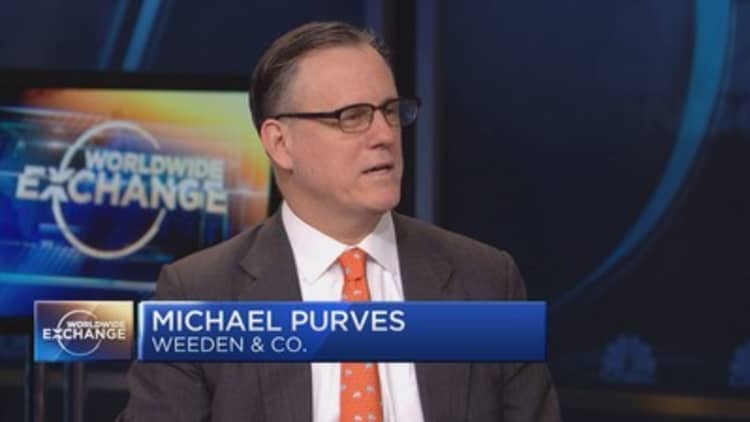
The Dow Jones industrial average has finally hit 20,000, and if it closes above that mark on Wednesday, it will surely be a market milestone. But if the long wait for Dow 20,000 already tired you out, don't feel bad.
Dow 20,000 is not quite like running a four-minute mile or breaking the sound barrier. It's little more than an imaginary line.
As a practical matter, Dow 20,001 will make investors richer than Dow 20,000, but surely won't get as much attention. Big round numbers are easier to remember and visualize than the ones marking records leading up to them, just as the 20-foot pole vault seems easier to imagine than 19 feet, 11½ inches.
"Hitting 20,000 is significant only in terms of its emotional and psychological impact on us," said Jeremy Torgerson, CEO of NVest Advisors in Brownsville, Texas. "We humans love round numbers.
"Remember New Year's Day 2000, as a recent example," he added. "That new year was somehow more meaningful than January 2, 2001, or January 1, 1999."
The Dow's climb up over time can't make any claim to being a natural law of market evolution. It's purely a human invention,created by The Wall Street Journal in 1896, and its makeup changes from time to time based on choices by editors at S&P Dow Jones Indices.
"The fact that people even monitor the Dow is an artifact of history," said Robert Johnson, president of the American College of Financial Services in Bryn Mawr, Pennsylvania.
It is the only price-weighted market index, a methodology that more heavily emphasizes moves by higher priced stocks than their lower priced counterparts — without sound logic, in Johnson's opinion.
"People still refer to how many points the Dow is up or down, even though a 100-point move is roughly half a percent today and it was approximately 5 percent at the time of the 1987 crash," Johnson said.
The fact that people even monitor the Dow is an artifact of history.Robert Johnsonpresident of the American College of Financial Services
If the Dow were a typical average, prices of the 30 stocks would be added up and divided by 30. But instead the calculation uses a much smaller divisor — currently 0.14602128057775. The divisor has been adjusted over the decades to account for stock splits, spin-offs, mergers and stock dividends, to assure that numbers from before and after yield apples-to-apples comparisons.
What really matters to investors is percentage gains, not the number of points the Dow adds over time. So going from 1,000 to 2,000 doubled investors' money, as did 5,000 to 10,000 and 10,000 to 20,000.
Up and down Dows
Investors may also be interested in how the Dow behaves after passing a big milestone. Unfortunately, there's no pattern dependable enough to bet on.
"Back in 1999, we hit 10,000 and the market continued to run another 1,000 points, but in January 2000, the market went from 11,900 down to 9,600," recalled Michael Darvish, senior financial advisor with Regal Securities in New York. "There is no specific pattern.
"It depends on the economic conditions," he added. "We are on a Trump high right now. Last January, we had a sell-off, and I would not be surprised if we get another one this year as investors want to take some money off the table."
Dow doublings
How long do Dow doublings take?
Fifteen years to go from 1,000 to 2,000 (1972–1987)
Four years from 5,000 to 10,000 (1995–1999)
About 17 years from 10,000 to 20,000 (1999–???)
An investor who wanted to bet on gains in the Dow could buy the 30 stocks, buy a fund that holds large-capitalization stocks including those in the Dow or make a pure play with SPDR Dow Jones Industrial Average ETF (DIA), an exchange-traded fund that owns the 30 Dow stocks.
But unless you own DIA, chances are your own results are different from the Dow's. The other big-name stock index ETF, the Standard & Poor's 500 (SPY), contains 500 stocks versus the Dow's 30, but tends to move about the same as the Dow over time, since it also is composed of large-cap issues. But if you own foreign stocks, or small-company stocks, or shares in specific sectors, the Dow 20,000 may not matter much to you.
"What matters is not where the Dow is, or how round that number is, but how one's own portfolio of investments is doing," said Michal Strahilevitz, behavioral economist at Duke University's Center for Advanced Hindsight. "For the wisest of investors, that will include a diverse range of index funds and such and not just a fund that tracks the Dow."
A real milestone: Debt $20 trillion
Investors may be cheered by a milestone.
"It is significant because, from a momentum perspective, once people see Dow 20,000 then they can be convinced that Dow 25,000 is possible," said Ted Jenkin, CEO of Oxygen Financial in Alpharetta, Georgia.
But they should not use the Dow milestone as an excuse to alter their long-term plan. "That is the best advice for anyone, no matter what the Dow has done, is doing or will do," Strahilevitz said. "Timing the market based on anything is a fool's strategy.
"It fails at least as often as it works."
More from Quarterly Investment Guide:
Think small ... caps: Big fund managers reaping big returns by shunning the Dow
As Dow nears 20,000, these sectors can take it higher
Dow nearing 20,000, but there are still deals for value investors
Stocks go down as well as up, of course, and the march to a new record is often interrupted by big downturns, such as the dotcom selloff and financial crisis crash that came between Dow 10,000 and 20,000. Smaller sell-offs come when investors decide to nail down profits after a big run and move to cash or some other holding. Deeper declines are often triggered by worries about corporate earnings or the health of the economy.
Erik Davidson, chief investment officer for Wells Fargo Private Bank, worries that the U.S. is quickly approaching another milestone that could dampen market performance: $20 trillion in government debt. He calculates that, while the Dow has produced a total return, including reinvested dividends, of 153 percent since the start of the 21st century, the debt has gone up 253 percent.
"While we will likely be seeing many Dow 20,000 hats, I sincerely doubt that we will see a single Debt $20 Trillion hat," Davidson said. "That says a lot about where the market is focusing these days."
— By Jeff Brown, special to CNBC.com
(Update: This story has been updated to reflect the Dow opening above 20,000 on Wednesday, Jan. 25.)



